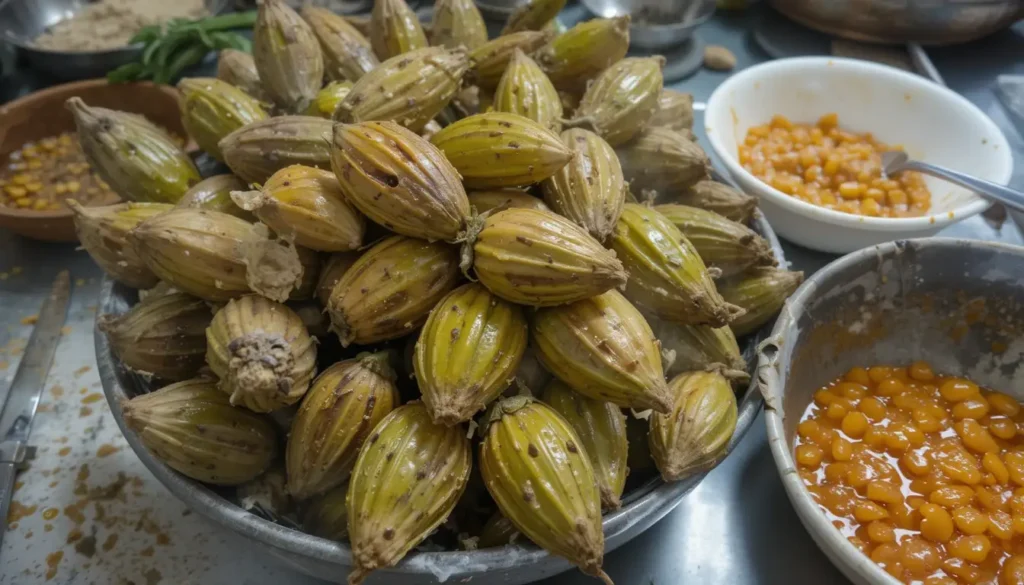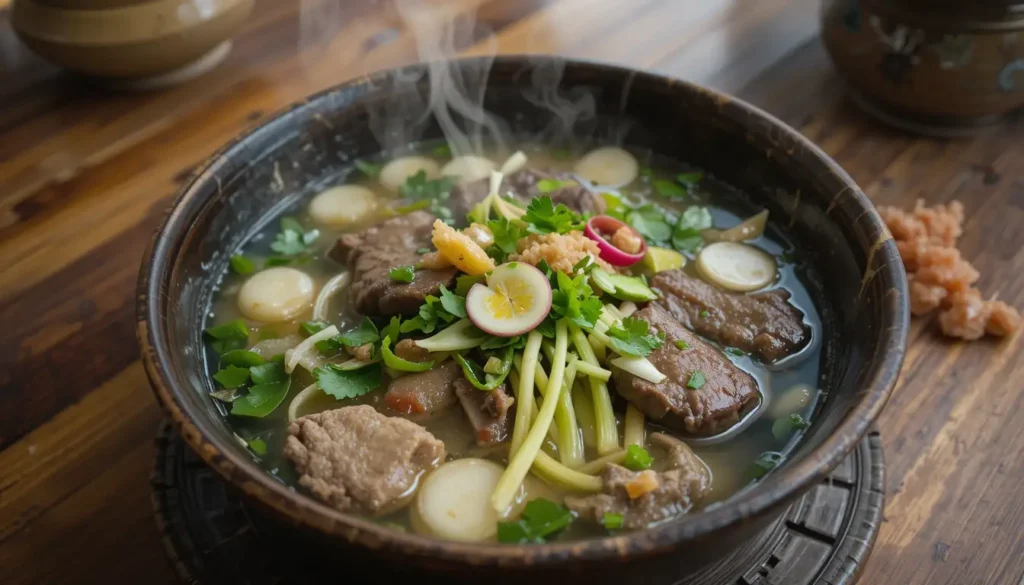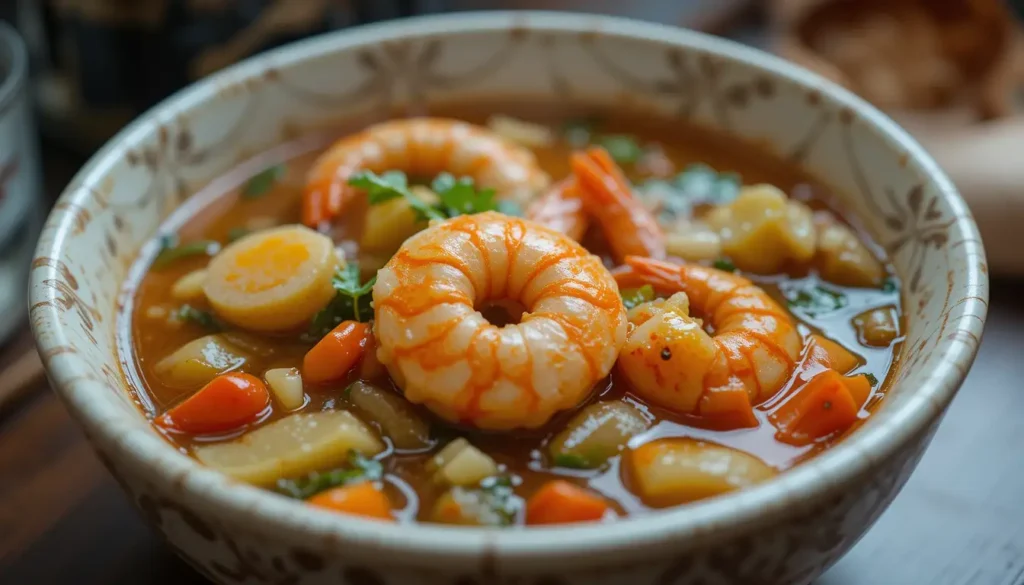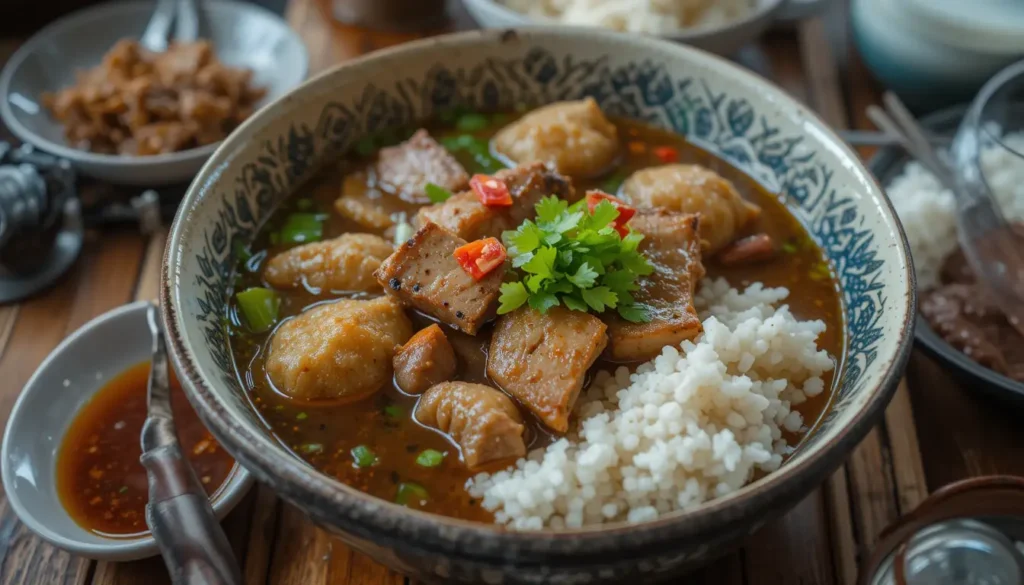Sinigang is a traditional Filipino dish deeply rooted in the country’s culinary history. The name “sinigang” is derived from the Filipino term sigang, which means “to stew.” Its sour flavor profile distinguishes it from other Filipino soups like tinola and bulalo. Historical records suggest that tamarind, a primary ingredient for sinigang’s tangy broth, has been a staple in Southeast Asian cuisine for centuries.
Table of Contents
Origins and Cultural Significance
Sinigang is not just food; it’s an experience that reflects Filipino warmth and hospitality. Typically served during family gatherings, fiestas, or simple weeknight dinners, the dish embodies the spirit of sharing and community. Its comforting nature has earned it a place as a quintessential Filipino comfort food.
Unique Features of Sinigang
What makes sinigang recipe unique is its adaptability and reliance on fresh, local ingredients. The dish’s core appeal lies in the sour broth, traditionally achieved using ripe tamarind. Other souring agents, like calamansi, green mangoes, or kamias, can also be used, depending on regional preferences or seasonal availability.
Key features include:
- Versatility: Sinigang can be made with beef, chicken, shrimp, fish, or even tofu for a vegetarian twist.
- Fresh Vegetables: Commonly added vegetables like kangkong (water spinach), radish, okra, and eggplant enhance the dish’s nutritional value and texture.
- Flavor Balance: Achieving the perfect harmony of sourness and savoriness is the hallmark of a well prepared sinigang.
Ingredients Needed
To prepare a flavorful and authentic sinigang recipe, you’ll need a combination of fresh ingredients that bring out the dish’s signature tangy and savory flavors. Below are the essential components, along with variations to suit different preferences.
Essential Ingredients

- Protein
- Shrimp (with shells for added flavor)
- Fish (such as milkfish or salmon)
- Beef (shank or brisket)
- Tofu (for vegetarian options)
- Tamarind (Souring Agent)
- Tamarind pulp or fresh tamarind pods: The traditional choice for a rich, authentic sour taste.
- Tamarind soup mix: A convenient alternative for those short on time.
- Substitutes: Calamansi juice, green mangoes, or kamias (bilimbi fruit) offer regional variations.
- Vegetables
- Kangkong (Water Spinach): Adds freshness and a slightly earthy flavor.
- Radish (Labanos): Thinly sliced for mild, crisp texture.
- Eggplant (Talong): Soaks up the broth, enhancing flavor.
- Okra: Adds thickness to the soup.
- Green Beans: Offers a subtle crunch.
- Tomatoes: Provides a tangy base for the broth.
- Onions: Deepens the savory profile of the soup.
- Seasonings
- Fish sauce: Adds umami and enhances the overall flavor.
- Salt and pepper: For seasoning to taste.
- Water or Stock
- Water is the common base, but chicken or shrimp stock can elevate the flavor.
Variations of Protein Choices
- Shrimp Sinigang: Shrimp adds a light and seafood inspired twist. The shells infuse the soup with a natural sweetness.
- Fish Sinigang: Fish like milkfish or salmon are ideal for a healthier option.
- Vegetarian Sinigang: Tofu and more vegetables, like squash and mushrooms, provide a hearty meatless option.
Importance of Tamarind or Alternatives
Tamarind is central to sinigang’s flavor. However, in its absence, other souring agents like calamansi or green mangoes can substitute. These alternatives bring their unique flavor profiles but maintain the essential sour taste that defines the dish.
Step-by-Step Instructions
Now that you have all the ingredients ready, it’s time to dive into the preparation and cooking process. Follow these detailed steps to create a flavorful sinigang recipe that captures the essence of this iconic Filipino dish.
Preparing the Ingredients

- Wash and Prepare the Vegetables
- Rinse all vegetables thoroughly under cold water to remove dirt and debris.
- Slice the radish into thin rounds.
- Cut the eggplant into wedges and soak in salted water to prevent discoloration.
- Trim the ends of the okra and leave whole.
- Chop the kangkong into 2-3 inch pieces, separating the stalks and leaves.
- Slice the tomatoes and onions thinly for even cooking.
- Prepare the Tamarind Pulp (if using fresh)
- Boil fresh tamarind pods in a small pot of water until soft.
- Mash the pods to extract the pulp, then strain to remove seeds and fibers. Set the tamarind juice aside.
- Prepare the Protein
- For beef: Cut into serving sized pieces and rinse thoroughly.
- For shrimp: Devein and clean the shrimp while leaving the shells intact for flavor.
- For fish: Clean and slice into desired portions.
- For tofu: Cut into cubes and fry lightly for a firmer texture.
Cooking Sinigang recipe: The Process
- Sauté the Base Flavors
- In a large pot, heat a tablespoon of oil over medium heat.
- Sauté the onions until translucent, then add the tomatoes. Cook until the tomatoes soften and release their juices.
- Add the Protein
- If using beef, add the meat to the pot. Sauté for 5-7 minutes until lightly browned.
- For shrimp or fish, this step will come later, as seafood cooks quickly.
- Simmer with Water or Stock
- Pour in water or stock, enough to submerge the ingredients (about 6 cups). Bring to a boil, then reduce to a simmer.
- Skim off any scum or impurities that rise to the surface for a clearer broth.
- Incorporate the Tamarind Juice
- Add the tamarind pulp or soup mix to the pot. Start with a small amount, then taste and adjust as needed to achieve the desired sourness.
- Add the Vegetables
- Begin with the hardier vegetables like radish and okra, cooking them for about 5 minutes.
- Add the eggplant and green beans, followed by the kangkong stalks. Save the kangkong leaves for the final minute of cooking to retain their freshness.
- For Seafood Variations
- Add the shrimp or fish during the last 5 minutes of cooking to prevent overcooking.
- Season the Soup
- Add fish sauce for a savory depth of flavor. Adjust with salt and pepper to taste.
- Simmer and Serve
- Allow the sinigang to simmer for an additional 2-3 minutes, ensuring all ingredients are tender and well seasoned.
- Serve hot in a large bowl, optionally garnished with fresh chilies for a spicy kick.
Adjusting Flavors to Taste
- If the broth is too sour, balance it with a small amount of sugar or more water.
- If it’s not sour enough, add more tamarind juice or another souring agent.
- For a richer broth, allow the soup to simmer longer, especially for beef versions.
Popular Variations of Filipino sinigang recipe
Sinigang’s versatility has inspired numerous variations, each offering a unique twist on the classic sour soup. Whether it’s the rich and hearty beef sinigang, the light and refreshing shrimp sinigang, or a vegetarian friendly version, there’s a sinigang recipe to suit every palate.
Sinigang na Hipon (Shrimp Sinigang)
A lighter, seafood based option, shrimp sinigang is perfect for those who prefer a quicker and easier-to-cook variation.
- Key Ingredients:
- Fresh shrimp with shells intact, as they release a natural sweetness into the broth.
- Vegetables like green beans, eggplant, and kangkong enhance the dish’s vibrant flavors.
- Cooking Tips:
- Add the shrimp during the last 5 minutes of cooking to avoid overcooking and ensure a tender, juicy texture.
- Substitute some water with shrimp stock for a more pronounced seafood flavor.
Sinigang na Isda (Fish Sinigang)
Fish sinigang offers a lighter and healthier alternative, often made with milkfish (bangus) or salmon.
- Key Ingredients:
- Fish fillets or chunks, paired with vegetables like mustard greens or bok choy for a unique twist.
- Tamarind or calamansi juice for the sour base.
- Cooking Tips:
- Use fish with firm flesh to prevent it from breaking apart during cooking.
- For a deeper flavor, fry the fish lightly before adding it to the broth.
Vegetarian Sinigang
For plant-based eaters, vegetarian sinigang is a flavorful, meat-free option.
- Key Ingredients:
- Tofu as the protein base, paired with an assortment of vegetables like squash, mushrooms, and green beans.
- Tamarind or kamias for sourness.
- Cooking Tips:
- Lightly fry the tofu before adding it to the soup to maintain its shape and texture.
- Experiment with different vegetables to suit your taste and nutritional needs.
Regional Variations
Sinigang evolves based on regional preferences:
- Sinigang sa Bayabas (Guava Sinigang): A sweeter variation using guava as the souring agent.
- Sinigang sa Miso: Combines tamarind and fermented soybean paste for a tangy, umami rich broth.
- Sinigang na Baka (Beef Sinigang): Uses beef shank or brisket, often paired with taro for a creamier consistency.
These variations showcase sinigang’s adaptability while retaining its signature sour and savory character.
Tips for the Best Sinigang

To create a memorable sinigang recipe that bursts with flavor, it’s essential to pay attention to the details. From choosing fresh ingredients to mastering the balance of sourness and savoriness, these tips will help elevate your sinigang recipe to perfection.
Choosing Fresh Ingredients for your Sinigang recipe
- Protein Quality
- Beef: Opt for fresh cuts like Beef belly or ribs with a good balance of meat and fat. This ensures a tender texture and rich flavor.
- Seafood: For shrimp or fish, choose fresh, firm options with no fishy odor. Fresh seafood will infuse the broth with natural sweetness.
- Vegetables
- Select vibrant, crisp vegetables free from blemishes. Freshness not only enhances flavor but also provides better texture.
- Avoid overcooking vegetables like kangkong or okra to retain their nutritional value and crunch.
- Souring Agents
- Use fresh tamarind or natural substitutes like calamansi for the most authentic taste. Pre-packaged tamarind soup mix can be a time-saving option but may have additives.
Mastering the Broth
- Simmer Slowly
- Allow the protein, particularly beef, to simmer over low heat. This ensures tender meat and a deeply flavored broth.
- Layer the Flavors
- Start with sautéing onions and tomatoes to build a savory base before adding water or stock.
- Introduce the tamarind gradually, tasting as you go, to achieve the perfect level of sourness.
- Use Stock for Depth
- Replace water with shrimp or chicken stock to enhance the richness of the broth.
Adjusting Flavors
- Balancing Sourness
- If the broth is too tangy, a teaspoon of sugar can mellow the flavor without overpowering the dish.
- For added sourness, incorporate more tamarind or a squeeze of calamansi juice toward the end of cooking.
- Savory Boost
- Use fish sauce sparingly to avoid overpowering the dish. Start with a tablespoon, then adjust to taste.
- Spicy Kick (Optional)
- Add green chilies or siling haba for a subtle heat that complements the tangy broth.
Pairing Sinigang with Side Dishes
- Steamed Rice
- Sinigang is best enjoyed with plain steamed rice, which soaks up the flavorful broth beautifully.
- Crispy Fried Dishes
- Complement sinigang’s tangy profile with crispy sides like fried fish or beef belly (lechon kawali). The contrasting textures and flavors create a satisfying meal.
- Dipping Sauces
- Pair with a simple dipping sauce of fish sauce, calamansi, and chili for an extra burst of flavor.
Pro Tips for Variations of the traditional sinigang dish

- Seafood Sinigang: Use shrimp heads to enhance the broth’s sweetness before discarding them.
- Vegetarian Sinigang: Add a splash of coconut milk for a creamy twist.
- Beef Sinigang: Include taro or gabi to thicken the broth and provide a silky texture.
FAQs About Sinigang
To ensure your sinigang is a success and to address common curiosities, here are answers to frequently asked questions about this iconic Filipino dish.
What makes sinigang different from other Filipino soups?
Answer: Sinigang stands out for its signature tangy broth, traditionally made with tamarind. Unlike other soups like tinola, which have a savory ginger base, or bulalo, known for its rich beef flavor, sinigang is characterized by a perfect balance of sourness and savoriness, often paired with fresh vegetables.
Can I make this sinigang recipe without tamarind?
Answer: Yes! While tamarind is traditional, other souring agents like calamansi juice, kamias (bilimbi fruit), green mangoes, or even tomatoes can be used. Tamarind soup mix is also a convenient alternative when fresh tamarind is unavailable.
How do I prevent overcooking vegetables for this sinigang recipe?
Answer: Add vegetables in stages, starting with the firmest ones like radish and okra, which take longer to cook. Leafy greens like kangkong should be added last, during the final minute of cooking, to retain their vibrant color and texture.
Can sinigang be reheated?
Answer: Absolutely! Without a doubt, sinigang reheats well and, in fact, often tastes even better the next day as the flavors meld together more deeply. To reheat, simply bring the soup to a gentle simmer over medium heat, making sure to avoid overcooking the vegetables for the best texture and taste.
What are good substitutes for fish sauce?
Answer: If you prefer to avoid fish sauce, you can use soy sauce or salt for seasoning. For a more complex umami flavor, miso paste can be added, particularly in seafood variations.
Is sinigang recipe healthy?
Answer: Yes, sinigang is indeed a highly nutritious dish! Not only is it packed with vitamins and minerals from the fresh vegetables, but it also offers lean protein options like fish or shrimp, making it a well rounded meal. Moreover, by adjusting the amount of fish sauce, you can easily control sodium levels, which further enhances its health benefits.
Conclusion
Sinigang is more than just a meal—it’s a celebration of Filipino heritage and a comforting dish that warms the soul. With its distinct tangy sour broth and medley of fresh ingredients, sinigang recipe has earned its place as one of the Philippines’ most beloved dishes. Whether you prefer beef, shrimp, or a vegetarian version, a sinigang recipe showcases the versatility that makes it perfect for any occasion.
Now that you have the recipe, tips, and answers to common questions, it’s time to bring the flavors of the Philippines to your kitchen. Enjoy your homemade sinigang and savor the comforting taste of this timeless dish!
Learn about complementary dishes like the hearty Dense Bean Salad Recipe to pair with your Sinigang.

